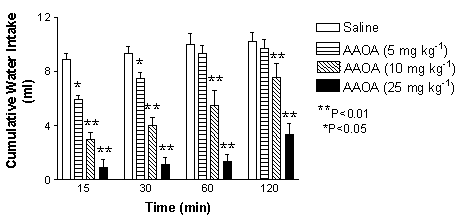| pA2 online © Copyright 2004 The British Pharmacological Society |
070P
University of Newcastle Winter Meeting December 2004 |
The effects of aminooxyacetic acid (AOAA) and β-alanine on water intake in water-deprived rats A.J. Houston, J.C.L. Wong & I.S. Ebenezer. Neuropharmacology Research Group, School of Pharmacy and Biomedical Sciences, University of Portsmouth, Portsmouth, PO1 2DT, U.K. |
|
It has previously been reported that both the GABAA receptor agonist muscimol and the GABAB receptor agonist baclofen inhibit water intake in thirsty rats by acting centrally (Ebenezer et al., 1992; Houston et al., 1995, 2002). The presence of GABA in brain areas involved in the regulation of water intake, such as the medial preoptic nucleus of the hypothalamus (Cooper et al., 1991), suggest that central GABA may play a physiological role in the control of water intake. The present study was undertaken to investigate the effects on water intake in rats of elevating central levels of GABA by either inhibiting the breakdown of GABA with aminooxyacetic acid (AOAA), a competitive inhibitor of GABA-transaminase, or β-alanine, an GABA reuptake inhibitor (Cooper et al., 1991).
Experiment.1. Male Wistar rats (n=8, b. wt. 300 – 330g) were deprived of water for 16h a day. Water intake was measured as described previously (Ebenezer, et al., 1992). Fifteen min prior to presentation of water in experimental cages, the rats were injected s.c. with either saline or AOAA (5, 10 and 25 mg
kg-1). Water intake measured at intervals over a 120 min period. A repeated measures design was used, with all rats receiving all treatments; 3- 4 days separated successive trials. The data were analysed by ANOVA.
Experiment 2. A similar experimental protocol was used except that a separate group of rats (male Wistar, n=8, b. wt. 350 – 400g) were injected with either saline or β-alanine (100, 200 and 400 mg kg-1; s.c.). AOAA (5 – 25 mg kg-1; Expt. 1) produced a dose-related decrease in water intake (see Fig. 1). The drug produced no overt abnormal behavioural changes at the lower doses, but the 25 mg kg-1 dose caused ataxia in some of the rats during the first 30 – 45 min after administration. β-Alanine (100, 200 and 400 mg kg -1; Expt. 2) also produced a dose-related decrease in water intake, with the 200 and 400 mg kg-1 doses significantly reducing cumulative water intake during the first 60 min after exposure to water in the experimental cages. Thus, for example, the mean cumulative water intake (ml) ± s.e. mean at 30 min was as follows: Saline 11.75 ± 0.5 ml; β-alanine (100 mg kg-1) 10.4 ± 0.3 ml; β-alanine (200 mg kg-1) 8.4 ± 0.4 ml (P<0.05); β-alanine (400 mg kg-1) 8.1 ± 0.5 ml (P<0.05). None of the doses produced overt abnormal behavioural changes in the animals. The results of this study show that inhibiting the reuptake of GABA or preventing its breakdown produces significant inhibition of water intake in thirsty rats. These findings tentatively suggest the possibility that GABA may play a physiological role in the regulation of water intake.

Fig. 1. The effects of AOAA on water intake. Vertical lines rep. + s.e.mean.
Ebenezer, I.S. et al (1992) Gen. Pharmacol ., 23, 375 - 379.
Houston, A.J. et al. (1995) Br. J. Pharmacol., 114, 305P.
Houston, A.J. et al. (2002) Physiol. Behav..77, 445 – 450.
Cooper, J.R. et al. (1991) The Biochemical Basis of Neuropharmacology, OUP.